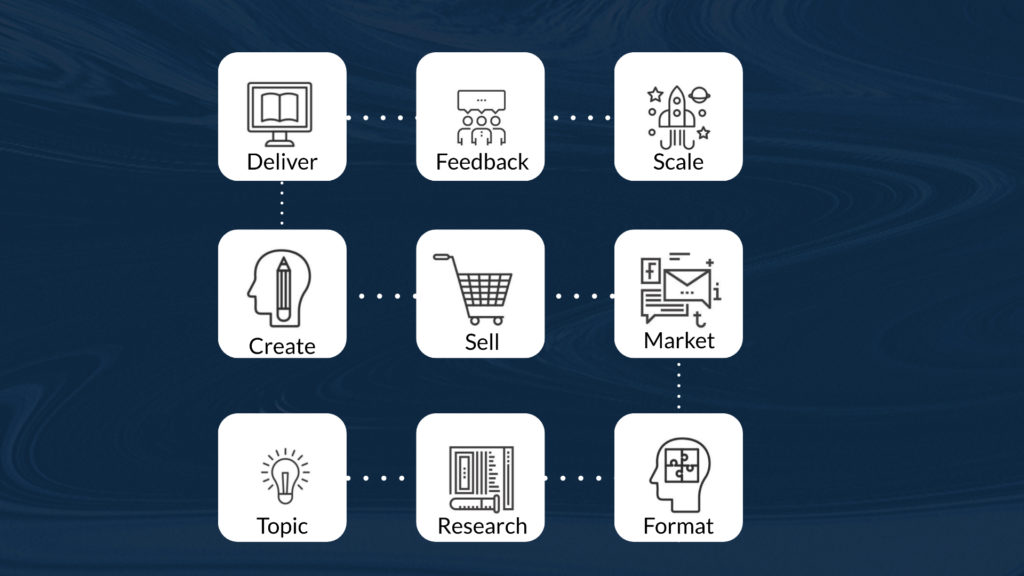You have an idea for an online course topic, but how do you know if it will become a profitable online course? How do you create an online course outline from that topic idea?
This post will take you through the process of creating and launching your successful online course.
Start with the best online course topic idea for your business model. Then validate it with your target audience, by finding out what they ‘want’ to learn. Move on to marketing, selling, creating the content, and delivering your course.
Gather feedback, testimonials, and the social proof you need, before you open it up to a wider potential audience.
Take this step by step approach to your successful course.
How To Create An Online Course – The Steps

Step 1 – Topic
The first major step in the process is to decide the topic. The topic has to be a fit within your business model. Your course should cover a fundamental step. Something that will give them a quick win (within four to eight weeks), and whet their appetite for more. This increases the chance that they will want to move up into your higher ticket offers. These could be group, mastermind, or 1:1 programmes.
This makes it an excellent way of bringing more of your target audience into your world. They will develop more know, like, and trust with you. So more will to want to take the learning and transformation achieved further with you.
Where your course should be in your business model.
Step 2 – Market Research
To validate that there is a market for your course, it is best to ask your target market, what they want to learn about the topic.
Please do not skip this major step. All too often people avoid market research, feeling that:
1. They know their target audience – Dangerous assumption, you can always learn.
2. They don’t have time – Make time, without knowing your market, you are shooting in the dark.
3. It will slow the process down – Much better to create something your target audience wants, than spend time creating something they don’t want.
Invite some of your ideal clients, to take part in the market research. Establish where they are, and where they want to get to.
Ideally, get 20 to 30 people to take part in this market research. You can make a few posts on social media. Send an email to your list. Contact past and present clients or prospects and invite them to take part in the market research.
Ask them what problems or pains and frustrations they have around the topic. Ask what they want to learn, how they want to learn it and how much they would pay.
Finding out in their words, how they speak about the problem you’re solving also gives you great insights into marketing copy. You can use these insights in posts, emails, sales pages and more. Using their language will always resonate better with them, than your own expert language.
Knowing what and how they want to transform allows you to design a course that they want to buy.
Step 3 – Format
The answers to what format it should be, how long, what is included and so on, will all come from the market research. In fact the whole process is driven by the market research. Remember you are creating what your market wants!
Properly structured questions will tell you all this. How long should it be? What should be included (audio, workbooks, assignments, templates, checklists, Facebook group, 1:1 calls etc.)? Live or pre-recorded? I always suggest live (more on that later). What price should it be?
Taking the market research answers and aggregating them will give you the most popular answers. Chances are that many will have given the same or similar answer to the questions asked.
Sometimes you may only have one person give a particular answer. So use your judgment whether to take it into account. Always give the greater weighting to answers from those that are most likely to be students.
Having narrowed down the format and what needs to be in the course, you can create an online course outline. What are the individual lessons you need to teach them to get the outcome they want?
How are you going to deliver that in the time frame they want to meet the learning goal?
Remember, you can’t teach everything you know in one course (at least it is unlikely, without being completely overwhelming for them). Deliver one outcome, one transformation, the first step on their journey with you.
Structure the modules so that the online course content will flow from one module to the next effortlessly. At this stage you are not creating the content, only the structure, what the course ‘needs’ to give them what they ‘want’!
Live vs Recorded
I suggest that the first run of any course is delivered as a series of live calls. This allows you to gain immediate feedback on the course content. Did they follow along? Are there areas that might need improvement? Having live calls allows you to gain this valuable feedback directly from the students.
A live course is also more valuable for the students involved. Because of the access to you, the commitment of showing up for the calls and having their questions answered. This will all increase the perceived value.
This also means you can charge more for it than you can a pre-recorded self directed course. You will also achieve a much higher completion rate. Which will lead to happier students, more testimonials and greater results.
The process of creating the course is also simpler. The live calls will become the backbone of the content, giving you the video lessons. Without the need to spend hours recording (and probably re-recording) video, editing and rendering.
It is also quicker to launch. Delivering live means that you can create the content as you go, rather than having to have everything ready before launching. If you prefer you can create the course as a pre-recorded self-directed course. But you will find it harder to gain feedback on the content. The completion rate will be a lot lower and generally the value will be perceived as lower.
Once you have gone through this process and refined the content, you will have the option of turning it into an ‘Evergreen’ course.
Step 4 – Market
There is a ready made market with the people that you spoke to in the market research phase. These are after all, the people that gave you the answers that you are designing your course around. So they will be your hottest prospects. This is another powerful reason to do the market research.
People in your network whether social media, email list, past or present clients and prospects, could all be ideal candidates for your course.
Find Joint Venture (JV) partners. There could be people you know that are working with your ideal client already. See if they would be willing to let their followers know about your course.
Use the language learned in step two, to create emails, posts and other marketing materials. Talk to their pains and frustrations, dreams and desires in the words that resonate with them.
Talk about the top problems they are facing, and the solutions you have to overcome them. Show your authority and why joining your course will be the perfect solution for them.
Step 5 – Sales
Make sales. These could, and probably in the first run, will be, from having sales calls with prospective students, rather than using sales funnels. Invite them to a call, take them through what the outcome of your course is, what problems you solve, and the format, and what is included in the course. Define who it is for, and who it is not for.
This is a powerful way of making people resonate with you, as well as deterring those that it is not for. Never be afraid to polarize opinion (who wants to be vanilla?).
Make an offer to them to join the course if they are a fit. Depending on how you collect money already, or the course platform used, you could take payment over the phone/Zoom, send an invoice, or a link to buy via your course platform.
Step 6 – Create
Now that you have made sales, and validated that there is a desire for your course, you can begin to create the content. If you are doing a pre-recorded course, then you need to prepare all the content, videos, workbooks, checklists, assignments, etc., before you can deliver the course.
If delivering live, you can create much of the content as you go. The material only needs to be ready before the next live call. Delivering a live course brings great advantages for your beta course launch.
You will have a higher completion and success rate, so more testimonials your course works. And, you will be able to gain immediate feedback on how the students are understanding the content. They are also quicker to get to launch, as mentioned above, you can create the content as you go!
Step 7 – Deliver
Now that you have created and sold your course you need to deliver. How this is done will depend on the format chosen in step 3.
If you’re doing a pre-recorded course, then you need to have all the content, videos, workbooks, checklists, assignments, etc. ready and uploaded to the course platform. You will need to give your students access to the course content. Depending on the platform chosen, you can either enrol the students yourself and send them the access information or get them to sign up and pay directly and get sent access automatically.
If you’re delivering the training live, then make sure your students have the access link to join you live. If you are using Zoom (or equivalent) create a meeting that is for all the calls, so you can use the same link for each session.
Step 8 – Feedback
When you have launched and delivered the first version of your new course, you want to get feedback from your first students about your course.
Did they get the outcome that was promised? Was the content well delivered? Was it enough to make a difference? Was it all well explained?
If you’re delivering live, much of this can be gathered as you go along. If there was a common problem or block, then you need to address it. If live you can course correct as you go. If it is pre-recorded, you can still get feedback, and you may need to make changes to the content.
The goal is to make it work for the students. Not only for the satisfaction of making a difference in their lives. But also to get as much positive feedback, glowing testimonials and social proof as possible.
Some simple questions for testimonials:
1. What problem did you have?
2. What had you tried to solve this problem?
3. What were the results of taking part in my course?
4. What would you say to anyone considering taking the course?
Step 9 – Scale
Now that your beta launch is done, the feedback gathered and refinements to the content made, you are ready to relaunch it to a wider audience. Use the testimonials and social proof to show that it delivers the transformation promised.
How you do this will vary depending on the type of course. If delivering live, then you may want to relaunch three times or more a year. You can always make it ‘evergreen’ by using the live call recordings already made as the content.
If pre recorded, it can be ‘evergreen’, so people can start it whenever they are ready. Or have them join at specific times when you have a marketing ‘push’ and launch.
Leverage JV contacts if you can. They are a great source of potential buyers without you having any upfront costs, unlike adverts. Depending on the arrangement made, you may pay a commission to the JV partner. But only after the sale, and only on the course, not on any further purchases made.
Advertising. Depending on your market and course, you could use advertising platforms such as Facebook, Google or YouTube. Test what copy resonates with the audience. The research from step 2 will certainly help here.
Make your connections on social media, your email list, clients and prospects aware about your course. Promote it to them before relaunch.
Conclusion
Whilst there is enough in this guide to get you up and running, there is a limit to what can be contained in it. So there are many lessons that can be learned still.
If you want to fast track your success, and find out what you don’t know around how to create an online course, then take action by getting in touch with me. I can help with the other elements of success too. Information is only one part, but with support and accountability to take action then you succeed!



